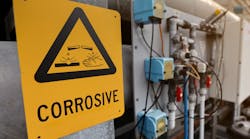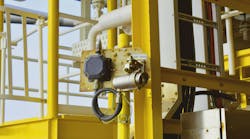Datastick Systems, Inc., introduced the VSA(TM)-1214 and VSA-1215 Vibration Spectrum Analyzers, its new-generation PDA-based vibration data collectors and analyzers that enable facilities to use vibration analysis in machine-condition monitoring, predictive maintenance and routine troubleshooting to reduce costs and downtime.
The pocket-sized system includes the all-new Datastick VSA-1214 or VSA-1215 Vibration Spectrum Analyzer module attached to a Palm T|X handheld computer with Datastick Spectrum version 1.6 software, which collects vibration measurements and displays and stores them as time waveforms and FFT spectra. The system also includes the new version 1.6 of Datastick Reporting System(TM) (DRS) for VSA, which imports the data from the handheld into a special Microsoft Excel-based application on the PC.
The new system features a new Datastick hardware module with a redesigned, low-noise analog input for standard ICP-type accelerometers and velocity sensors, optimized digital circuitry and a built-in rechargeable lithium-ion battery with proprietary power management circuitry to allow the VSA-1215 to operate and power ICP sensors far beyond an eight-hour shift.
The VSA-1215 system displays and records overall vibration and ISO vibration severity alerts, as well as acceleration waveforms with a resolution of up to 6,400 points (3,200 points for the VSA-1214); and acceleration, velocity or displacement spectra with up to 3,200 lines of FFT resolution (1,600 FFT lines for the VSA-1214). User-selectable maximum frequencies range from 20 KHz down to 50 Hz (10 KHz to 50 Hz for the VSA-1214). The tenth-order hardware antialiasing filter provides a clean signal, while new low-noise electronics and specialized algorithms keep the noise floor low so that velocity signals are useable down to 1 Hz (60 CPM - cycles per minute).
Datastick Spectrum version 1.6 allows users to record vibration data directly onto removable Secure Digital (SD) cards that have been inserted into the Palm handheld. SD cards with capacities of 2 GB and higher are commonly available, and users can use as many cards as they like, so overall storage capacity is unlimited.
Users transfer vibration data to a PC either by using the Palm handheld's pushbutton HotSync feature or by copying the data directly from the SD card. Datastick Reporting System (DRS) on a Windows PC automatically organizes the information by machine and creates histories so you can analyze the machine behavior over time.




